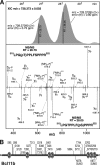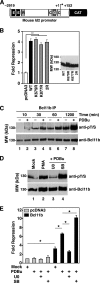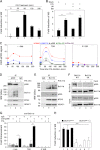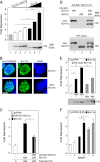Coordinated regulation of transcription factor Bcl11b activity in thymocytes by the mitogen-activated protein kinase (MAPK) pathways and protein sumoylation
- PMID: 22700985
- PMCID: PMC3411033
- DOI: 10.1074/jbc.M112.344176
Coordinated regulation of transcription factor Bcl11b activity in thymocytes by the mitogen-activated protein kinase (MAPK) pathways and protein sumoylation
Abstract
The transcriptional regulatory protein Bcl11b is essential for T-cell development. We have discovered a dynamic, MAPK-regulated pathway involving sequential, linked, and reversible post-translational modifications of Bcl11b in thymocytes. MAPK-mediated phosphorylation of Bcl11b was coupled to its rapid desumoylation, which was followed by a subsequent cycle of dephosphorylation and resumoylation. Additionally and notably, we report the first instance of direct identification by mass spectrometry of a site of small ubiquitin-like modifier (SUMO) adduction, Lys-679 of Bcl11b, in a protein isolated from a native, mammalian cell. Sumoylation of Bcl11b resulted in recruitment of the transcriptional co-activator p300 to a Bcl11b-repressed promoter with subsequent induction of transcription. Prolonged treatment of native thymocytes with phorbol 12,13-dibutyrate together with the calcium ionophore A23187 also promoted ubiquitination and proteasomal degradation of Bcl11b, providing a mechanism for signal termination. A Bcl11b phospho-deSUMO switch was identified, the basis of which was phosphorylation-dependent recruitment of the SUMO hydrolase SENP1 to phospho-Bcl11b, coupled to hydrolysis of SUMO-Bcl11b. These results define a regulatory pathway in thymocytes that includes the MAPK pathways and upstream signaling components, Bcl11b and the associated nucleosome remodeling and deacetylation (NuRD) complex, SENP proteins, the Bcl11b protein phosphatase 6, the sumoylation machinery, the histone acetyltransferase p300, and downstream transcriptional machinery. This pathway appears to facilitate derepression of repressed Bcl11b target genes as immature thymocytes initiate differentiation programs, biochemically linking MAPK signaling with the latter stages of T-cell development.
Figures










Similar articles
-
Kinetic analysis of BCL11B multisite phosphorylation-dephosphorylation and coupled sumoylation in primary thymocytes by multiple reaction monitoring mass spectroscopy.J Proteome Res. 2014 Dec 5;13(12):5860-8. doi: 10.1021/pr5007697. Epub 2014 Nov 25. J Proteome Res. 2014. PMID: 25423098 Free PMC article.
-
Alteration of Bcl11b upon stimulation of both the MAP kinase- and Gsk3-dependent signaling pathways in double-negative thymocytes.Biochem Cell Biol. 2019 Apr;97(2):201-213. doi: 10.1139/bcb-2018-0132. Epub 2018 Oct 23. Biochem Cell Biol. 2019. PMID: 30352171
-
Protein Kinase C-Mediated Phosphorylation of BCL11B at Serine 2 Negatively Regulates Its Interaction with NuRD Complexes during CD4+ T-Cell Activation.Mol Cell Biol. 2016 Jun 15;36(13):1881-98. doi: 10.1128/MCB.00062-16. Print 2016 Jul 1. Mol Cell Biol. 2016. PMID: 27161321 Free PMC article.
-
Interplay of the SUMO and MAP kinase pathways.Ernst Schering Res Found Workshop. 2006;(57):193-209. doi: 10.1007/3-540-37633-x_11. Ernst Schering Res Found Workshop. 2006. PMID: 16568956 Review.
-
Role of the transcription factor Bcl11b in development and lymphomagenesis.Proc Jpn Acad Ser B Phys Biol Sci. 2012;88(3):72-87. doi: 10.2183/pjab.88.72. Proc Jpn Acad Ser B Phys Biol Sci. 2012. PMID: 22450536 Free PMC article. Review.
Cited by
-
Targeting the Transcriptome Through Globally Acting Components.Front Genet. 2021 Sep 16;12:749850. doi: 10.3389/fgene.2021.749850. eCollection 2021. Front Genet. 2021. PMID: 34603400 Free PMC article. Review.
-
Epigenetic Dynamics in the Function of T-Lineage Regulatory Factor Bcl11b.Front Immunol. 2021 Apr 14;12:669498. doi: 10.3389/fimmu.2021.669498. eCollection 2021. Front Immunol. 2021. PMID: 33936112 Free PMC article. Review.
-
Interplay between cofactors and transcription factors in hematopoiesis and hematological malignancies.Signal Transduct Target Ther. 2021 Jan 20;6(1):24. doi: 10.1038/s41392-020-00422-1. Signal Transduct Target Ther. 2021. PMID: 33468999 Free PMC article. Review.
-
Bcl11b Regulates IL-17 Through the TGF-β/Smad Pathway in HDM-Induced Asthma.Allergy Asthma Immunol Res. 2018 Sep;10(5):543-554. doi: 10.4168/aair.2018.10.5.543. Allergy Asthma Immunol Res. 2018. PMID: 30088373 Free PMC article.
-
SUMO and Transcriptional Regulation: The Lessons of Large-Scale Proteomic, Modifomic and Genomic Studies.Molecules. 2021 Feb 5;26(4):828. doi: 10.3390/molecules26040828. Molecules. 2021. PMID: 33562565 Free PMC article. Review.
References
-
- Deribe Y. L., Pawson T., Dikic I. (2010) Post-translational modifications in signal integration. Nat. Struct. Mol. Biol. 17, 666–672 - PubMed
-
- Johnson L. N., Lewis R. J. (2001) Structural basis for control by phosphorylation. Chem. Rev. 101, 2209–2242 - PubMed
-
- Narayanan A., Jacobson M. P. (2009) Computational studies of protein regulation by post-translational phosphorylation. Curr. Opin. Struct. Biol. 19, 156–163 - PubMed
-
- Meulmeester E., Melchior F. (2008) Cell biology: SUMO. Nature 452, 709–711 - PubMed
-
- Tempé D., Piechaczyk M., Bossis G. (2008) SUMO under stress. Biochem. Soc. Trans. 36, 874–878 - PubMed
Publication types
MeSH terms
Substances
Grants and funding
LinkOut - more resources
Full Text Sources
Molecular Biology Databases
Miscellaneous

